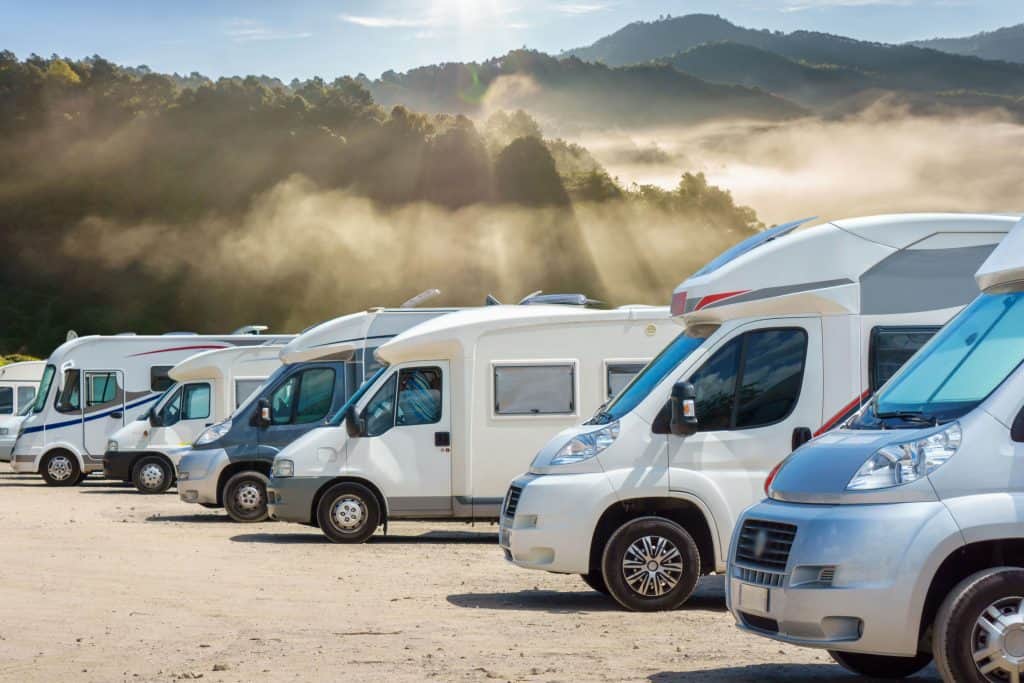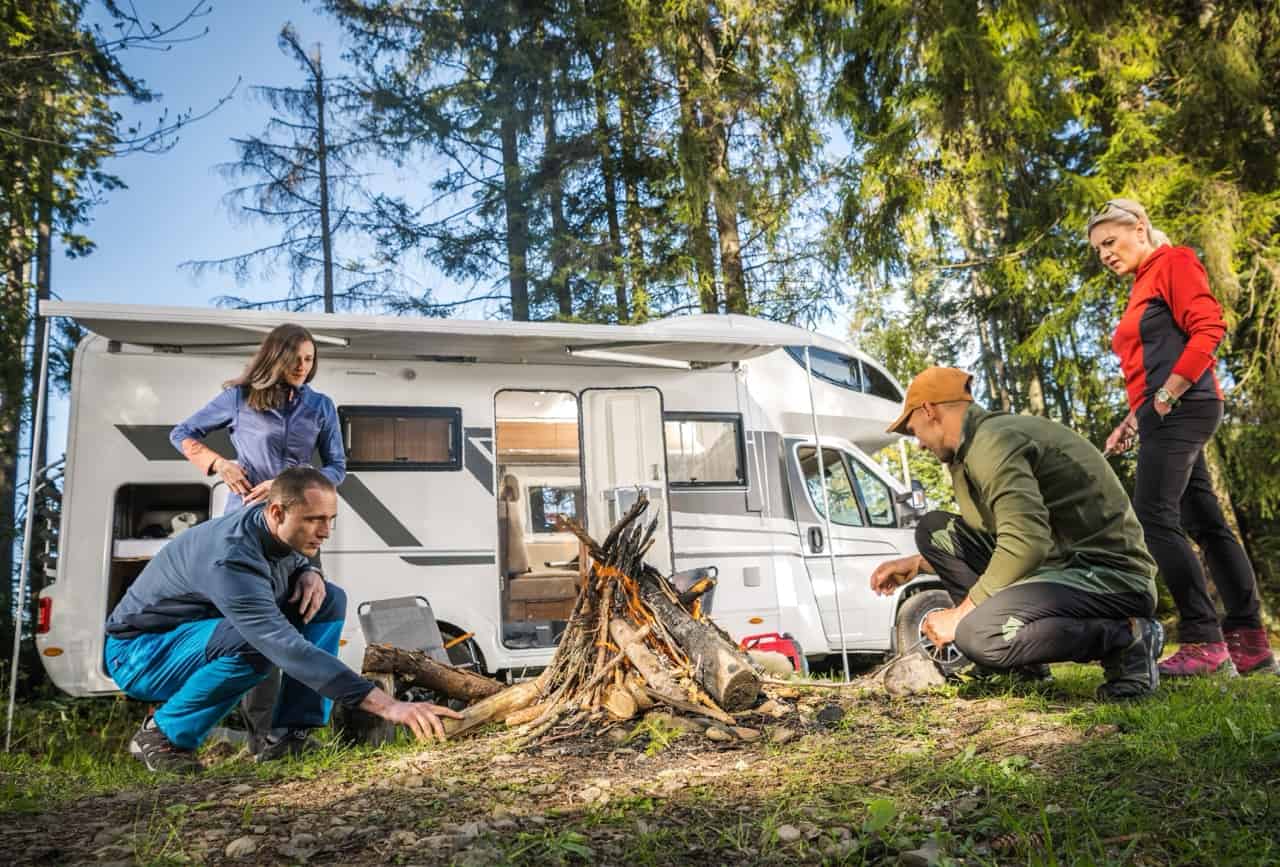
If you just purchased or are considering buying a motorhome, one of your biggest concerns is probably whether or not it will be hard to drive. I recently wondered the same thing, and I did a bit of research that might help us both.
Are motorhomes hard to drive? Motorhomes are not difficult to drive, so it makes sense that they’re exploding in popularity. The size of a motorhome can affect its driveability, but a bit of practice and some common-sense driving skills should make any motorhome easy to handle.
Certain factors can affect just how difficult a given motorhome is to drive. Inexperienced drivers might want something small; experienced drivers will probably be more confident with big motorhomes.
What Can Make Motorhomes Hard to Drive?
Motorhomes, as I mentioned before, are generally surprisingly easy to drive. They’re not too tricky to navigate, and modern motorhomes often come equipped with cameras all around that give you a good view of your surroundings.
If a motorhome is especially long, however, turns can be difficult. If you’re not used to driving extended vehicles such as buses, semi-trailer trucks, etc., you’ll have to practice turning without hitting the cars to your sides or overestimating the break in traffic into which you’re trying to fit. You probably shouldn’t ever attempt a U-turn in a motorhome. More often than not, it’s way too risky.)
Heavy motorhomes can be tough to keep control of. They’re not only more of a load than your typical sedan or even SUV; the weight is distributed differently in a motorhome than it is in a smaller vehicle.
Heavy vehicles are harder to bring to a complete stop than small, lightweight vehicles. Furthermore, clearance under bridges is something you’ll need to be far more wary of in a motorhome than in a car.
If you have a compact motorhome, you probably won’t have much trouble at all keeping it under control. Regardless, it’s always smart to practice as many defensive driving skills as possible when driving any vehicle, especially if it’s bigger than what you usually handle.
What Are the Easiest Motorhomes to Drive?
While Class A and Class C motorhomes are enticing, they’re often massive and take some extra skill to navigate. Class B motorhomes are small and barely even qualify as motorhomes, so they might not be ideal if you’re planning for a lot of passengers, but they’re just as easy to drive as a truck or an SUV.
Class B motorhomes are super simple to set up. They can easily host one or two passengers comfortably. There’s room enough in a Class B motorhome for all the necessary amenities for these two passengers, and they’re ideal for day trips and quick errand runs.
However, the space in a Class B motorhome is limited, so more than two passengers probably can’t fit comfortably inside with all the necessary living supplies. Storage and cargo areas also tend to be minimal, so these aren’t great for long-haul trips.
If you’re willing to settle for a happy medium between Class A and Class B motorhomes, a Class C motorhome might be the right fit for you. They can range from twenty to thirty-three feet, they’re large enough for an entire family, they’re self-contained with all the basic amenities necessary for comfortable travel, and they’re much cheaper to maintain and easier to manage than Class A motorhomes.
Keep in mind, though, that even though Class C motorhomes are cheaper than Class A motorhomes, they’re still relatively expensive to maintain.
They’re difficult to take out on errands without the assistance of an extra vehicle. Furthermore, driving a Class C motorhome can be significantly more difficult than driving a Class A motorhome.
The easiest motorhome to handle might depend simply on your experience. A Class B motorhome as long as forty-five feet might be a piece of cake for you to drive, or it might seem impossible to control.
Determine what size of motorhome you want to buy based on your personal intuition and prior driving experience.
If you don’t know much about the motorhome-purchasing process and you still can’t decide what size is right for you, feel free to browse our site. Here is a page of motorhome-related topics that should help you out.
Differences Between Driving a Car and Driving a Motorhome
If you’re used to driving a car, you might feel prepared to tackle a motorhome on the open road. You might be surprised, however, what drastic differences there are between driving a car and driving a motorhome.
In the interest of your own safety and the safety of those around you on the road, I’ve compiled a few critical differences between driving a car and driving a motorhome that you should be aware of before you hit the road.
- The road view: The road view in a car is drastically different from the road view in a motorhome. You can’t see much directly in front of you. Keep this in mind as you drive. Keep your eyes on the road at all times.
- The turn radius: I mentioned this once before, but a little reinforcement never hurt anybody. Motorhomes tend to be much longer than cars, so corner turns are especially difficult. The average motorhome has 2 to 2 1/2 feet of tail swing when it is turning, so keep that in mind.
- Gassing up: You’ll have to fuel your motorhome more often than you have to fuel your car, and even the fueling process itself is different for RVs than it is for smaller vehicles. Stop at gas stations meant specifically for trucks and larger vehicles to avoid damaging your motorhome on the gas pump.
- Speed: Some roads (especially high-speed roads like freeways, highways, and interstates) require large vehicles to maintain a speed five or ten miles slower than small vehicles. Keep your eyes on the road signs around you, and if you’re going to be driving through a new state or area, do some research so you can be sure to comply with local laws.
- Width: Some highways are narrowed to the legal minimum width (about eight feet and six inches) when they’re being worked on. If your motorhome is eight feet wide, you’ll have to be especially wary of these varying widths. Sometimes,
damage is unavoidable, so keep drills, duct tape, and other damage-control resources handy. Try to drive in the right lane on the highway and keep your speed five to ten miles under the limit, even when it’s not required. - Repairs: Repairs on your motorhome might not be as high-class as those on your prized sportscar. Gorilla tape is sometimes all you need to patch up a slightly damaged headlight, and pop rivets should help you put hanging, post-brush-with-a-truck parts back where they belong. Of course, if damage to your motorhome is restricting your ability to drive safely, you should consider bringing it to a repair specialist.
- Size Rules: As a large RV, you have right-of-way over any smaller vehicles on the road. This doesn’t mean you should be any less considerate of your fellow drivers. Just be aware that smaller cars are obligated to make way if you can’t slow down or react in time.
- Stop Signs: The big, white bars painted on the road by stop signs aren’t there by accident. You should be able to still see that line in front of you when you stop in your motorhome so other cars can see and move around you.
- Long Sight: If you look directly ahead of you as you drive a motorhome, you’re going to feel like you constantly need to adjust the position of the steering wheel. If you look further down the road, you’ll see that your motorhome is actually fairly steady, and you won’t feel the need to adjust its steering wheel so much.
- Rest Stops: This one might be subjective, but even though passengers are allowed more movement in motorhomes than they are in smaller vehicles, you should still stop often for some fresh air. This will help keep both the passengers and the driver alert and, thus, safe on the road.
Motorhome Driving Tips
Even if you’ve never driven a recreational vehicle before, you probably know enough about driving to navigate a motorhome.
However, before you tackle any especially crowded or narrow streets with your RV, you’ll need to master a few motorhome handling and driving practices that will make things safe and easy for you and for anyone else on the road.
- Be aware of everyone around you. According to the DMV, motorhomes can actually be easiest to handle when you’re driving down the interstate. Shockingly to most new motorhome owners, the real test of your driving skills is maneuvering an oversized vehicle through city streets or in the mountains, where road-side trees and narrow, unpaved paths can make the size of your motorhome all too clear. Be conscientious of everyone around you—especially in your blind spot.
- Pull through parking spots. Try not to pull into any parking spots behind another vehicle. Motorhome blind spots are bigger than those of smaller vehicles, so you want to avoid backing up as often as possible. Try to pull through parking spots so you can leave the lot without backing up and risking any damage to your vehicle or someone else’s.
- Keep a good distance between you and the vehicle in front of you. This one is very important. The bigger the vehicle, the longer it takes to brake. If the car in front of you has to stop suddenly and you’re riding its bumper, you probably won’t be able to stop in time. To avoid fender benders and more serious accidents, keep a safe distance between you and whatever vehicles are in front of you.
- Be ready to brake when necessary. Once again, your motorhome’s breaks will not stop your vehicle as quickly as those on your Honda Accord. While this might seem obvious, many drivers forget to take your motorhome’s size into account. You have to be extremely vigilant and ready to brake at all times, just in case someone cuts you off and you have to slow down abruptly.
- Travel in a group. If you have friends with motorhomes, consider “caravaning” when you travel. This isn’t necessarily a definite principle, of course. Some drivers are exceptionally aggressive and won’t shy from a group of motorhomes. You’ll still want to remain extra vigilant and aware of the drivers around you, but cars tend to give groups of motorhomes wider berths than they would a single RV.
- Pay attention to the wind. Just as the wind can affect your abilities when driving a car, it can greatly impact your safety when driving a motorhome. Driving slowly when the wind is strong, and keep a good grip on the wheel. Keep in mind that the wind might even affect your motorhome more so than it would your car. Try to compensate for this extra danger with extra-precise driving skills.
- Remember how tall your motorhome is. Don’t just take familiar routes because they’re familiar. Your car might not have had any trouble fitting under that bridge, but your motorhome might. Take your motorhome’s height into account as you drive.
- Watch your acceleration. Heavy vehicles pick up speed on a downslope more quickly than light vehicles and cars, and they’re more difficult than cars to regain control of once they’ve gained speed. Keep your motorhome’s speed in check, especially when you’re going downhill.
- Watch out for distractions. Passengers especially pose a great danger to motorhome drivers. Not only do they talk, but they watch TV, they play cards, they cook, and they do anything else one might do in a regular home. Try to be aware as you drive your motorhome that you are infinitely more susceptible to distraction than you would be in a car.
- Be courteous to other drivers on the road. Not everyone on the road is going to adhere to your same rules of etiquette, so you can’t always control whether or not other drivers drive safely. You can, however, drive safely yourself and hope other drivers will follow suit.
There is another article on our site about driving RVs. It gives some great tips that apply just as easily to motorhomes, and I won’t go into full detail since you can read all about them here, but I’d like to at least summarize the points we haven’t hit yet. They’re great to keep in mind as you drive any large vehicle.
Don’t assume that you’re a “pro” just because you’ve driven your motorhome or RV a few times already. Keep practicing. There will probably always be something you don’t quite understand.
Parallel parking, for instance, is a major challenge for most motorhome drivers. Don’t ever slack off just because you think you’ve had enough experience.
Don’t drive when you’re tired. Motorhome driving demands exceptional observance. Drowsiness is dangerous in any vehicle, but especially in one of such size and with such power over others on the road. Don’t try to compensate for fatigue with caffeine. It can distract you just as much as a lack of sleep can.
Adjust your mirrors when necessary. Make sure they offer the greatest possible visibility every time you head out on the road. It’s simply not as easy to see behind you in a motorhome as it is in a car.
If your motorhome isn’t already equipped with cameras so you can see all around you as you drive, consider purchasing some.
Finally, keep an eye on the weather report of both your current and potential locations. You won’t have to pack up your motorhome every time it rains, but try to avoid driving it in extreme weather (especially in the snow! Skidding is a big deal in a motorhome).
Related Questions
Is it normal for my motorhome to make noises as I drive? Most motorhomes make some noises that veteran car drivers don’t expect. Your motorhome shouldn’t be rattling down the road (if it is, you should definitely take it in for a checkup), but don’t worry too much if you hear some odd sounds.
Cabinets might open and shut. Your toaster might shake and sound like a dry engine. Assess the sound before you freak out. Odds are, it’s nothing to be concerned about.
Should child passengers in a motorhome be restrained? Some states require seat belts in the front seats only. Others don’t require seat belts at all. Keep up-to-date on the guidelines of every state through which you plan to travel so you don’t violate any laws.
If you’re mostly concerned about safety, though, it’s probably a good idea to keep all child passengers seat-belted when the motorhome is in action.
Is there a nation-wide motorhome speed limit? The typical RV speed limit is 70 miles per hour on rural interstates and 55 miles per hour on urban freeways. It’s always a good idea, however, to keep an eye out for signs and changes in the recommended RV speeds in certain areas.
And, of course, you should keep updated on individual states’ laws, as there isn’t a set, nation-wide speed limit applicable to every road.



